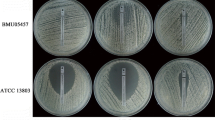Abstract
Azole resistance of Candida tropicalis has, in recent years, become a serious issue in hospitals; however, there is limited knowledge of the mechanisms underlying this resistance. We have previously demonstrated that ERG11 plays a vital role in azole resistance in C. tropicalis. Here, we describe the expression and sequence variation of UPC2, which encodes a transcription factor of ERG11. Quantitative real-time RT-PCR showed that 31 azole-resistant C. tropicalis strains significantly overexpressed UPC2. Those isolates resistant to all three azole antifungals upregulated UPC2 expression to a greater degree than those resistant to only fluconazole or itraconazole. The UPC2 promoter contains mutations −118T-G and −155G-A in azole-resistant strains of C. tropicalis. Meanwhile, the mutation G392E was also detected twice in UPC2 gene in azole-resistant C. tropicalis and was demonstrated to mediate azole antifungal susceptibility by using Saccharomyces cerevisiae as an expression host, particularly for fluconazole and itraconazole.



Similar content being viewed by others
References
Hube B. From commensal to pathogen: stage- and tissue-specific gene expression of Candida albicans. Curr Opin Microbiol. 2004;7:336–41.
Mayer FL, Wilson D, Hube B. Candida albicans pathogenicity mechanisms. Virulence. 2013;4:119–28.
Silva S, Negri M, Henriques M, Oliveira R, Williams DW, Azeredo J. Candida glabrata, Candida parapsilosis and Candida tropicalis: biology, epidemiology, pathogenicity and antifungal resistance. FEMS Microbiol Rev. 2012;36:288–305.
Mane A, Vidhate P, Kusro C, Waman V, Saxena V, Kulkarni-Kale U, et al. Molecular mechanisms associated with Fluconazole resistance in clinical Candida albicans isolates from India. Mycoses. 2016;59:93–100.
Vandeputte P, Tronchin G, Rocher F, Renier G, Bergès T, Chabasse D, et al. Hypersusceptibility to azole antifungals in a clinical isolate of Candida glabrata with reduced aerobic growth. Antimicrob Agents Chemother. 2009;53:3034–41.
Neto JB, da Silva CR, Neta MA, Campos RS, Siebra JT, Silva RA, et al. Antifungal activity of naphthoquinoidal compounds in vitro against fluconazole-resistant strains of different Candida species: a special emphasis on mechanisms of action on Candida tropicalis. PLoS One. 2014;9:e93698.
Jiang C, Dong D, Yu B, Cai G, Wang X, Ji Y, et al. Mechanisms of azole resistance in 52 clinical isolates of Candida tropicalis in China. J Antimicrob Chemother. 2013;68:778–85.
MacPherson S, Akache B, Weber S, De Deken X, Raymond M, Turcotte B. Candida albicans zinc cluster protein Upc2p confers resistance to antifungal drugs and is an activator of ergosterol biosynthetic genes. Antimicrob Agents Chemother. 2005;49:1745–52.
Silver PM, Oliver BG, White TC. Role of Candida albicans transcription factor Upc2p in drug resistance and sterol metabolism. Eukaryot Cell. 2004;3:1391–7.
White TC, Silver PM. Regulation of sterol metabolism in Candida albicans by the UPC2 gene. Biochem Soc Trans. 2005;33:1215–8.
Dunkel N, Liu TT, Barker KS, Homayouni R, Morschhäuser J, Rogers PD. A gain-of-function mutation in the transcription factor Upc2p causes upregulation of ergosterol biosynthesis genes and increased fluconazole resistance in a clinical Candida albicans isolate. Eukaryot Cell. 2008;7:1180–90.
Choi MJ, Won EJ, Shin JH, Kim SH, Lee WG, Kim MN, et al. Resistance mechanisms and clinical features of fluconazole-nonsusceptible Candida tropicalis isolates compared with fluconazole-less-susceptible isolates. Antimicrob Agents Chemother. 2016;60:3653–61.
Versalovic J, Koeuth T, Lupski JR. Distribution of repetitive DNA sequences in eubacteria and application to fingerprinting of bacterial genomes. Nucleic Acids Res. 1999;19:6823–31.
Silva AP, Miranda IM, Guida A, Synnott J, Rocha R, Silva R. Transcriptional profiling of azole- resistant Candida parapsilosis strains. Antimicrob Agents Chemother. 2011;55:3546–56.
Vandeputte P, Ischer F, Sanglard D, Coste AT. In vivo systematic analysis of Candida albicans Zn2-Cys6 transcription factors mutants for mice organ colonization. PLoS One. 2011;6:e26962.
Oliver BG, Song JL, Choinniere JH, White TC. cis-Acting elements within the Candida albicans ERG11 promoter mediate the azole response through transcription factor Upc2p. Eukaryot Cell. 2007;6:2231–9.
Sasse C, Dunkel N, Schäfer T, Schneider S, Dierolf F, Ohlsen K, et al. The stepwise acquisition of fluconazole resistance mutations causes a gradual loss of fitness in Candida albicans. Mol Microbiol. 2012;86:539–56.
Hoot SJ, Smith AR, Brown RP, White TC. An A643V amino acid substitution in Upc2p contributes to azole resistance in well-characterized clinical isolates of Candida albicans. Antimicrob Agents Chemother. 2011;55:940–2.
Acknowledgments
This work was supported by National Natural Science Foundation of China (Grants Nos. 81371873, 81572053 and 81301462).
Author information
Authors and Affiliations
Corresponding author
Additional information
Cen Jiang and Qi Ni have equally contributed to this work and are co-first authors.
Rights and permissions
About this article
Cite this article
Jiang, C., Ni, Q., Dong, D. et al. The Role of UPC2 Gene in Azole-Resistant Candida tropicalis . Mycopathologia 181, 833–838 (2016). https://doi.org/10.1007/s11046-016-0050-3
Received:
Accepted:
Published:
Issue Date:
DOI: https://doi.org/10.1007/s11046-016-0050-3




